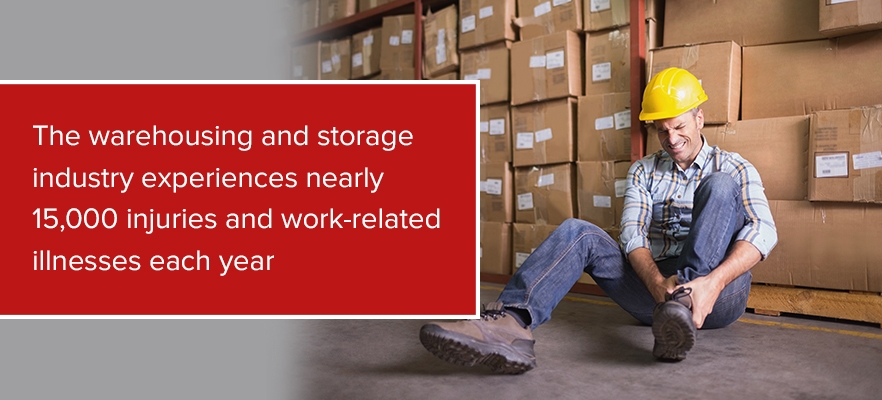Complete Guide to Warehouse Management: Chapter 4
Chapter 5: Managing Warehouse Safety: Compliance, Facility Security and Worker Well-Being
Safety and security aren’t just buzzwords in the warehousing community — they dictate the way things are done.
Any warehouse manager should understand the responsibility of this domain. From a practical standpoint, running a safe and secure warehouse reduces the risk for occupational, on-the-clock injuries — and its laundry list of associated costs. It also means fewer interruptions along the workflow pipeline, less equipment downtime due to misoperation and an overall, positive work environment that prioritizes employee health and well-being.
None of these variables are to be taken lightly. Yet they often aren’t systematized or straightforward in warehouse operations, aside from standardized rules like wearing safety equipment.
When managing warehouse safety and security, an abstract ideal that often stays just that — abstract. Managers must consider what safety really means across daily operations on their floor:
-
Safe yet productive, ergonomic handling machinery.
-
Readily available and task-appropriate safety equipment for all personnel.
-
Clear, designated work areas and zones — especially if any space is legally categorized as hazardous.
-
A clean and orderly work environment.
-
A secure facility with a private, access-only warehouse floor.
-
Proactive safety training or courses for all employees, not just during onboarding.
-
And much more, described below.

Managing Warehouse Safety and Security
There are many warehouse management procedures you can adopt today to better cultivate industry-leading safety and security.
1. Risk Assessments
Conducting a warehouse risk assessment allows you to get the most comprehensive picture of security needs within your operations.
You can train internally to perform one or bring in a third-party auditor. A complete risk assessment will cover environmental elements like inventory handling operations, equipment available for workers, physical stressors on workers and the condition of available equipment. Other reviewed categories include things like compliance documentation, racking and falling object assessment, warehouse vehicle traffic routes and worker safety heights when on ladders or operating lifts.
Risk assessments can also help you identify workflow pinch points in your system, plus other safety categories that affect total operating performance. Ensure you have a thorough risk assessment procedure in place.
2. Electric and Hydraulic Safety Circuits Within Machines
Many industry-specific storage warehouses contain hydraulic or electric infrastructure. These power generators, mechanical equipment, operational tools and unique storage solutions operate in large, around-the-clock capacities and in small, system-oriented tasks.
Safety features should already come standard with such machines. Yet it’s far from uncommon for warehouse managers to install further safety controllers and safety relays into their equipment, from remote e-stops and two-hand, no-tie-down buttons.
All these can help enhance your warehousing machinery fleet to “Performance Level D” (PLD) safety standards. Not only does this recognition mean your warehouse has fail-safes in place for various malfunctions or critical conditions, but it is also a clear way to demonstrate you take environmental and employee safety, well, personally.
3. Safety Fencing and Zoning
Many warehouse managers choose to fence in specialized machinery — or entire warehouse zones — for security purposes. These fences will come with swipe access or key-coded locks, further protecting expensive and operation-critical machinery with restricted employee access. Indeed, this kind of gated technology can even be installed at warehouse entry points.
4. Additional Warehouse Safety Guarding
The uses of safety scanners, e-stops, swipe-access cards and remote security controls have increased over the past decade. Given the proper network synchronization, they offer maximum warehouse security with around-the-clock, geographically unlimited oversight.
Managing Warehouse Compliance
According to the U.S. Bureau of Labor Statistics, the warehousing and storage industry experiences nearly 15,000 injuries and work-related illnesses each year.

Many of these injuries are due to neglected or flat-out ignored safety procedures. Anything from loosely shelved inventory or slippery floors to warehouse vehicles without movement-related alarms could spell catastrophe.
Following compliant warehouse operations should intuitive, with signs, training and safety equipment emphasized as just part of the job. Employees and managers who skirt safety and security protocol or rely on poor documentation of compliance efforts not only risk their own health — they could face serious regulatory consequences.
1. Machine Safety Certifications
Safety certifications remain one of the best ways to stay on top of compliant warehouse management. Only allow certified operators to use certain machines in your warehouse. You can set up tiers of certificates, with personnel working “up the ranks” of equipment operating by undergoing relevant training. Ensure all certificates get cataloged in your warehouse management computer system, and your company provides refresher courses.
2. Compliance Training
The Occupational Safety and Health Administration (OSHA), the American National Standards Institute (ANSI) and more exist solely to foster safer work environments. In an industry where manual labor meets a need for ever-efficient processes, your warehouse cannot afford to see these agencies as bureaucratic burdens.
Be proactive about OSHA-mandated and other regulatory agency trainings. Create a warehouse working environment where these guidelines and trainings are advertised and promoted. Include all levels of management and employees during their proceedings to encourage consensus and active employee buy-in.
3. Adopt a Safety Committee
Designate a team to help managers oversee all security and safety issues. This team should become the go-to personnel for such warehouse matters, creating a more horizontal organizational structure for security initiatives. Have the committee stay in charge of posting safety rules and regulations, assessing equipment and conducting trainings. Set up a transparent system of documentation for any new updates or procedures the committee enacts. Then acknowledge and reward the committee's active hard work.





